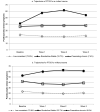Trajectories of posttraumatic stress symptoms after civilian or deployment traumatic event experiences
- PMID: 27845522
- PMCID: PMC5161718
- DOI: 10.1037/tra0000147
Trajectories of posttraumatic stress symptoms after civilian or deployment traumatic event experiences
Abstract
Objective: Growth mixture model studies have observed substantial differences in the longitudinal patterns of posttraumatic stress symptom (PTSS) trajectories. This variability could represent chance iterations of some prototypical trajectories or measurable variability induced by some aspect of the source population or traumatic event experience. Testing the latter, the authors analyzed a nationally representative sample of U.S. Reserve and National Guard members to identify the influence of civilian versus deployment trauma on the number of PTSS trajectories, the nature of these trajectories, and the proportion of respondents in each trajectory.
Method: Data were collected from 2010 to 2013 and latent class growth analysis was used to identify different patterns of PTSS in persons exposed to both a civilian and a deployment trauma and to test whether respondents' exposure to civilian trauma developed similar or distinct patterns of response compared to respondents exposed to deployment trauma.
Results: PTSS were found to follow 3 trajectories, with respondents predominantly clustered in the lowest symptom trajectory for both trauma types. Covariates associated with each trajectory were similar between the 2 traumas, except number of civilian-related traumatic events; specifically, a higher number of civilian traumatic events was associated with membership in the borderline-stable, compared to low-consistent, trajectory, for civilian traumas and associated with the preexisting chronic trajectory for military traumas.
Conclusions: Holding the source population constant, PTSS trajectory models were similar for civilian and deployment-related trauma, suggesting that irrespective of traumatic event experienced there might be some universal trajectory patterns. Thus, the differences in source populations may have induced the heterogeneity observed among prior PTSS trajectory studies. (PsycINFO Database Record
(c) 2017 APA, all rights reserved).
Figures
References
-
- American Association for Public Opinion Research Standard Definitions: Final Dispositions of Case Codes and Outcome Rates for Surveys. 2011 Retrieved from Lenexa, KS.
-
- American Psychiatric Association DSM-IV-TR: Diagnostic and statistical manual of mental disorders, text revision. 2000
-
- Bakker AB, Demerouti E. The job demands-resources model: State of the art. Journal of managerial psychology. 2007;22(3):309–328.
-
- Blanchard EB, Jones-Alexander J, Buckley TC, Forneris CA. Psychometric properties of the PTSD Checklist (PCL) Behaviour Research and Therapy. 1996;34(8):669–673. - PubMed
Publication types
MeSH terms
Grants and funding
LinkOut - more resources
Full Text Sources
Other Literature Sources
Medical
Molecular Biology Databases


